|
|
|
Sort Order |
|
|
|
Items / Page
|
|
|
|
|
|
|
| Srl | Item |
| 1 |
ID:
180859
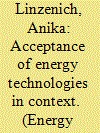

|
|
|
|
|
| Summary/Abstract |
In Carbon Capture and Utilization (CCU), CO2 captured from industrial processes replaces fossil feedstock used to produce of a variety of products, e.g., plastic products, fuels, or minerals. The roll-out of CCU will depend on the public's acceptance and risk perception. Whereas past studies exclusively focused on CCU risk perception, this study (n = 266) compared CCU to seven other infrastructure technologies (fossil, nuclear, renewable energies) to put the perceived CCU risks into perspective.
|
|
|
|
|
|
|
|
|
|
|
|
|
|
|
|
| 2 |
ID:
125398


|
|
|
|
|
| Publication |
2013.
|
| Summary/Abstract |
Utilizing a longitudinal study design, the impact of the 2011 accident in Fukushima on acceptance of nuclear power and the evaluation of several scenarios with different percentages of nuclear power were examined. Mail surveys were conducted in the German-speaking part of Switzerland. The first survey took place before the accident in Fukushima (Autumn 2010), the second survey immediately after the accident (March 2011), and the third survey half a year after the accident (October 2011). A sample of 463 persons participated in all three surveys. The accident had a negative impact on the acceptance of nuclear power. The mean change was moderate, and high correlations between the measurement points were observed. Overall, participants thus showed rather stable attitudes towards nuclear power across the three measurement waves. Results of the present study demonstrate the importance of prior beliefs and attitudes for the interpretation of an accident. The evaluation of the various scenarios was strongly influenced by participants' pre-Fukushima attitudes towards nuclear power.
|
|
|
|
|
|
|
|
|
|
|
|
|
|
|
|
| 3 |
ID:
150378
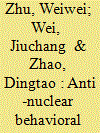

|
|
|
|
|
| Summary/Abstract |
This study explored the key factors underlying people's anti-nuclear behavioral intentions. The protective action decision model and the heuristic–systematic model were integrated and adapted from a risk information perspective to construct a hypothetical model. A questionnaire study was conducted on a sample of residents near the Haiyang Nuclear Power Plant, which is under construction in Shandong Province, China (N=487). Results show that, as expected, perceived knowledge is vital in predicting people's information insufficiency, information seeking, systematic processing, and risk perception. Moreover, the inverted U relationship between perceived knowledge and anti-nuclear behavioral intentions is indicated in the study. Information insufficiency and information seeking also significantly predict systematic processing. Furthermore, people's behavioral intentions are motivated by risk perception but fail to be stimulated by systematic processing. Implications and recommendations for future research are discussed.
|
|
|
|
|
|
|
|
|
|
|
|
|
|
|
|
| 4 |
ID:
174891
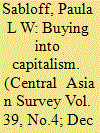

|
|
|
|
|
| Summary/Abstract |
Interviews with 864 everyday Mongolians in Hovd, Ulaanbaatar, and the surrounding countryside in 1998 and with 410 from the same locations in 2003 reveal they have an increasing appreciation of capitalism. Yet during the time of the research, Mongolians experienced economic and climatic hardships. Why would interviewees favour capitalism under such conditions? Cognitive analysis suggests that interviewees associate capitalism with the benefits of democracy, especially the economic and political freedoms gained since the demise of socialism. They anticipate not only that capitalism will allow them to improve their lives and make their own decisions but also that it will improve Mongolia’s standing in the world. Statistical analysis suggests respondents’ strong correlation between capitalism and democracy. It also suggests correlation between respondents’ perception of capitalism and risk (mostly optimism). However, their association of capitalism with democracy is greater than its correlation with risk perception. Therefore, I surmise that their love of democracy outweighs their concern for their economic future.
|
|
|
|
|
|
|
|
|
|
|
|
|
|
|
|
| 5 |
ID:
125602


|
|
|
|
|
| Publication |
2013.
|
| Summary/Abstract |
Despite considerable quantitative case study research on communities living with turbines, few have studied the roles played by the perceptions of: health risk, economic benefits/fairness, and intra-community conflict. We report the findings from a case-control survey which compares residents living with/without turbines in their community to understand the relative importance of these variables as predictors of turbine support. Ontario is the context for this study as it is a place where the pace of turbine installations is both very high and extremely politicized. As expected 69% of residents in the case community would vote in favour of local turbines yet surprisingly, only 25% would do so in the control community. Though the literature suggests that aesthetic preferences best predict turbine support the key predictors in this study are: health risk perception, community benefits, general community enhancement, and a preference for turbine-generated electricity. Concern about intra-community conflict is high in both the case (83%) and control (85%) communities as is concern about the fairness of local economic benefits (56% and 62%, respectively); yet neither is significant in the models. We discuss the implications of these findings particularly in terms of the consequences of a technocratic decide-announce-defend model of renewable facility siting.
|
|
|
|
|
|
|
|
|
|
|
|
|
|
|
|
| 6 |
ID:
160294


|
|
|
|
|
| Summary/Abstract |
This article seeks to measure the potential risk tolerance in tourism and to determine whether individuals’ rationality in daily life is consistent with their choice of destination for foreign travel. Findings of the research, carried out among Israeli students, indicate such a consistency: individuals with higher general risk aversion also have higher risk aversion in tourism. These results can give tourism service providers greater insight into how tourists make decisions, thus enabling them to offer destinations that are personally adapted to the travel experience and general risk tolerance of tourists.
|
|
|
|
|
|
|
|
|
|
|
|
|
|
|
|
| 7 |
ID:
137827


|
|
|
|
|
| Summary/Abstract |
The realm of ‘nuclear technology’ is amongst the most beguiling subjects of the human civilisation for the fact that words like ‘atom’ and ‘radiation’ have engendered both lasting fear as well as abounding hope in many. However, what is less certain is why it has entrenched such strong group (pro- and anti-nuclear) alignments. Fingers point towards the ‘risk’ associated with nuclear technology; but risk perception is a “combination of facts and fears, intellect and instinct, reason and gut reaction”; it is a ‘subjective’, not a purely rational and fact-based process. Therefore, any hasty response to a perceived risk may pose a danger by itself. Moreover, risk is calculated by multiplying the probability of the consequence by the severity of the consequence. On the other hand, the unrealised lofty goal of abundant energy through the nuclear route and a few nuclear disasters have given rise to public scepticism.
|
|
|
|
|
|
|
|
|
|
|
|
|
|
|
|
| 8 |
ID:
147616


|
|
|
|
|
| Summary/Abstract |
This article quantifies the impact of H7N9 bird flu on chicken demand and consumer willingness to pay (WTP) in China. We measure risk perception, fear and trust against actual reduction in consumption and stated change in WTP for safe chicken between 2012 and 2013. Through a survey conducted in each year on the same Chinese urban consumers, we found that the consumption of chicken never increased after the emergence of H7N9 in 2013, and WTP for safe chicken did not necessarily increase relative to generic risks associated with consuming chicken in 2012. Factors such as the fear of H7N9's spreading, the impact of distrust (especially the distrust in government) enhanced the deviation of consumption and WTP; and the sheer mentioning of H7N9 is more important and negative than whether it was associated with a risk-perception reducing or risk-perception elevating message given to consumers.
|
|
|
|
|
|
|
|
|
|
|
|
|
|
|
|
| 9 |
ID:
179693
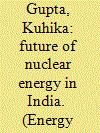

|
|
|
|
|
| Summary/Abstract |
Extant research has demonstrated that public support (or lack thereof) is a primary driver for the expansion (or decline) of the use of nuclear reactors as a significant source of energy. This study uses a national survey to explore the dynamics of public support for nuclear energy in India, which remains understudied. In doing so, the study also builds on existing research by analyzing key factors that have been shown to have an influence on public opinion about nuclear energy in other contexts such as the US, UK, South Korea, and China. Survey results indicate that there is substantial support for nuclear energy amongst the Indian public and that public perceptions about the benefits of nuclear energy outweigh the potential risks. Results also show that concerns about energy security and climate change correlate with support for nuclear energy, suggesting that members of the Indian public are willing to accept possible risks of nuclear energy to realize the benefits of energy security and, to a lesser extent, climate change mitigation.
|
|
|
|
|
|
|
|
|
|
|
|
|
|
|
|
| 10 |
ID:
166518
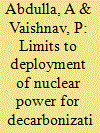

|
|
|
|
|
| Summary/Abstract |
Decarbonization will require deployment of low-carbon technologies, but analysts have struggled to quantify which ones could be deployed in practice—especially where technologies have faced public opposition. For nuclear power, some analysts have tried to solve this problem with caps on deployment or nuclear-free scenarios; however, social science research has not offered nuanced guidance about these caps. We deploy an experiment involving a large U.S. sample (N = 1226) to disentangle public opposition due to the dread of nuclear power from opposition stemming from its actuarial risk. Respondents are asked to build a power generation portfolio that cuts CO2 emissions, given information about the actuarial risks of technologies. Half the sample is exposed to the nuclear power label while the other half is treated with the risk information but blinded to the label. Respondents who see the labels deploy 6.6 percentage points less nuclear power as a share of the U.S. electricity mix. Our results suggest that dread about nuclear power leads respondents to choose 40% less nuclear generation in 2050 than they would have chosen in the absence of this dread. These methods could apply to other technologies, such as carbon storage, where there may be gaps between actuarial and perceived risks.
|
|
|
|
|
|
|
|
|
|
|
|
|
|
|
|
| 11 |
ID:
109652
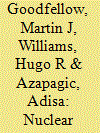

|
|
|
|
|
| Publication |
2011.
|
| Summary/Abstract |
There is currently an international drive to build new nuclear power plants, bringing about what is being termed a "nuclear renaissance". However, the public perception of nuclear energy has historically been, and continues to be, a key issue, particularly in light of the Fukushima nuclear incident. This paper discusses the disparity between perceived and calculated risks based on the last four decades of research into risk perception. The leading psychological and sociological theories, Psychometric Paradigm and Cultural Theory, respectively, are critically reviewed. The authors then argue that a new nuclear-build policy that promotes a broader approach to design incorporating a wider range of stakeholder inputs, including that of the lay public, may provide a means for reducing the perceived risk of a nuclear plant. Further research towards such a new approach to design is proposed, based on integrating expert and lay stakeholder inputs and taking into account broader socio-cultural factors whilst maintaining the necessary emphasis on safety, technological development, economics and environmental sustainability.
|
|
|
|
|
|
|
|
|
|
|
|
|
|
|
|
| 12 |
ID:
166514
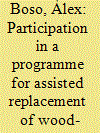

|
|
|
|
|
| Summary/Abstract |
Temuco and Padre Las Casas are two of the most polluted cities in southern Chile; around 90% of the particulate matter emissions are produced by wood-burning stoves used for domestic heating and cooking. Surveys were collected from 489 residents to examine differences between applicants and non-applicants to a programme to replace wood-burning stoves with pellet stoves. Results show that participants who applied to the programme are, on average, older than non-applicants, are more likely to have a respiratory impairment, tend to evaluate indoor air quality worse than non-applicants and tend to perceive the health effects of air pollution as more severe. The findings also suggest that motivation to improve air quality is a key aspect for understanding the adoption of pellet stoves when the requirement for initial investment is removed. Practical implications relating to the role of sociodemographic and psychological factors in the decision to replace heating systems are discussed to support the design of more effective interventions to mitigate wood smoke pollution.
|
|
|
|
|
|
|
|
|
|
|
|
|
|
|
|
| 13 |
ID:
109782


|
|
|
|
|
| Publication |
2011.
|
| Summary/Abstract |
Since the mid-1990s, academic and policy communities have debated the risk posed by terrorist use of chemical, biological, radiological, or nuclear (CBRN) weapons. Three major schools of thought in the debate have emerged: the optimists, the pessimists, and the pragmatists. Although these three schools of thought draw on the same limited universe of data on CBRN terrorism, they arrive at strikingly different conclusions. Given the highly subjective process of CBRN terrorism risk assessment, this article analyzes the influence of mental shortcuts (called heuristics) and the systemic errors they create (called biases) on the risk assessment process. This article identifies and provides illustrative examples of a range of heuristics and biases that lead to the underestimation of risks, the overestimation of risks and, most importantly, those that degrade the quality of the debate about the level of risk. While these types of biases are commonly seen as affecting the public's perception of risk, such biases can also be found in risk assessments by experts. The article concludes with recommendations for improving the CBRN risk assessment process.
|
|
|
|
|
|
|
|
|
|
|
|
|
|
|
|
| 14 |
ID:
149936


|
|
|
|
|
| Summary/Abstract |
Growing awareness of the potential for some energy-related activities to induce earthquakes has created a need to understand how the public evaluates the risks of induced earthquakes versus the benefits of energy development. To address this need, this study presents a web survey that used a between-subjects factorial experimental design to explore the views of 325 U.S. adults, who were asked about their experiences with earthquakes; risk perceptions related to different causes of earthquakes (e.g., natural versus induced); and acceptability of earthquakes depending on the benefits, beneficiaries, and decision making process. The results found that participants had more negative feelings toward induced versus naturally occurring earthquakes. Although they judged no earthquake as “acceptable,” participants rated induced earthquakes significantly less acceptable than naturally occurring ones. Attributing the benefits to the provision of renewable energy or climate change mitigation did not increase induced earthquake acceptability, and no particular beneficiary made earthquakes more acceptable, although private companies as beneficiaries made earthquakes less acceptable. Finally, induced earthquake acceptability was significantly higher when people believed that people like them had a voice in the decision to implement the technology that caused the earthquake, underscoring the importance of public engagement in the development of energy technologies.
|
|
|
|
|
|
|
|
|
|
|
|
|
|
|
|
| 15 |
ID:
166975
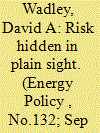

|
|
|
|
|
| Summary/Abstract |
This project probes perceptions of long-standing concern about high voltage electricity overhead transmission lines (HVOTL). Psychometric, cultural and broader risk analysis frameworks permit close examination of homeowners' worries about relevant externalities. Investigated via a telephone survey in Queensland, Australia, the most significant perceptions are hypothesized to relate to technologically-infused risks. Visual effects and noise are the key externalities but shield deeper qualms relating to electric and magnetic fields (EMFs). Safety, environmental damage and property impacts are less feared. Regression analysis indicates that prior knowledge about HVOTLs and a person's residential locale influence risk perception, along with gender and age. The research supports the underlying precepts of a ‘risk society’ while offering significant policy guidelines for infrastructure and associated agencies.
|
|
|
|
|
|
|
|
|
|
|
|
|
|
|
|
| 16 |
ID:
075779
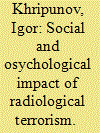

|
|
|
|
|
| Publication |
2006.
|
| Summary/Abstract |
The July 2005 terrorist attacks in London demonstrated the resilience of Western society in the face of low-level conventional terrorism. But the psychological damage from the London bombings would likely pale next to the severe, unpredictable, long-lasting effects of a radiological attack. One unique hazard of radiation exposure beyond the obvious physiological effects is that it is colorless, odorless, and tasteless, making it difficult for ordinary citizens to evaluate, quantify, and rationally understand the dangers confronting them. Radiological weapons stand out among the tools available to terrorists for their capacity to inflict far-reaching psychological damage to civilian populaces well beyond the immediate victims. A possible solution to mitigate the psychological consequences is to build a "resilience culture," an interlocking set of beliefs, attitudes, approaches, and behaviors that help people fare better in any disaster or extraordinary circumstance. The "all-hazards approach," which emphasizes the identifiable similarities among the "disaster triad"-that is, natural, accidentally man-made, and intentionally man-made disasters-extends to acts of terrorism and could help demystify the fears associated with radiological terrorist weapons.
|
|
|
|
|
|
|
|
|
|
|
|
|
|
|
|
| 17 |
ID:
186303
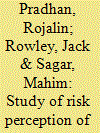

|
|
|
|
|
| Summary/Abstract |
Due to the ever-increasing use of mobile communications in India, health risks associated with exposure to radiofrequency electromagnetic field (RF-EMF) transmitted by mobile phones and base stations has become the focus of research. Internationally, there have been numerous studies on RF-EMF risk perception, but this issue is scarcely addressed in India. The present study evaluates the level of risk perception of Indians associated with RF-EMF exposure from mobile phones and base stations and assesses the underlying reasons for their concerns. We conducted a qualitative study on a small group of Indians (n = 25) from varied socioeconomic backgrounds, followed by a large-scale population (n = 500) survey to identify the primary issues of concern. The results show that many participants, irrespective of their social group, have a positive attitude towards mobile phones and are willing to accept the risks of using them, but are against the installation of base stations. Our study confirms that lack of knowledge about mobile communications technology, health concerns about mobile phones and base stations, community concern regarding base station deployment and media influence have a significant impact on risk perception among Indians. Carefully planned communication techniques are required to decrease risk perceptions and increase acceptance of mobile communications infrastructure.
|
|
|
|
|
|
|
|
|
|
|
|
|
|
|
|
| 18 |
ID:
177117
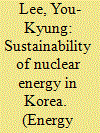

|
|
|
|
|
| Summary/Abstract |
The purpose of this study is to examine the impacts of nuclear energy risk perception, benefit perception, and political orientation on nuclear energy consumption behaviour from the nuclear energy users' perspectives. The existing studies on nuclear energy acceptance have mainly used local or public acceptance as outcome variables with a single dimension and haven't considered users' risk and benefit perceptions as multi-dimensional constructs. Therefore, this study examines the impacts of nuclear energy risk and benefit perceptions at social and personal levels on the attitude and usage intention towards nuclear energy. In addition, this study examines the relationships between political orientation, attitude, and usage intention towards nuclear energy. This study conducted hierarchical multiple regression analysis on 312 samples collected through random sampling from each region in Korea through the stratified sampling method. This study found that users with lower social and personal risk perceptions of nuclear energy and with higher social benefit perception of nuclear energy tend to have more positive attitude towards nuclear energy, and greater usage intention of nuclear energy. And this study also found that conservatives and authoritarians show more positive nuclear energy consumption behaviour than socilaists and libertarians. From these findings, the study discusses practical and theoretical implications for nuclear energy policies in Korea.
|
|
|
|
|
|
|
|
|
|
|
|
|
|
|
|
| 19 |
ID:
191109
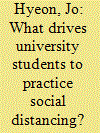

|
|
|
|
|
| Summary/Abstract |
As COVID-19 has caused unprecedented social change, governments are implementing several social measures to control transmission. Among them, social distancing is being enforced in almost all countries and is effective in preventing infection. Based on the importance of social distancing, this study identifies factors influencing the intention towards social distancing. The research model was developed by introducing risk perception in the theory of planned behaviour. To examine the proposed model, a survey was conducted with 339 university students from two countries, South Korea and Vietnam. The data were analysed using the partial least squares method. The results show that social distancing attitude and perceived behavioural control significantly influence social distancing intention. The findings indicate that both affective risk perception and cognitive risk perception serve as imperative factors in the formation of social distancing attitudes, subjective norms and perceived behavioural control. However, subjective norms and nationality do not affect social distancing intention. Based on the results, suggestions are made for policymakers to establish effective social measures.
|
|
|
|
|
|
|
|
|
|
|
|
|
|
|
|
| 20 |
ID:
132670


|
|
|
|
|
| Publication |
2014.
|
| Summary/Abstract |
The nuclear accident in Fukushima and the subsequent discussions about nuclear power influenced public acceptance of this technology. The aim of the present study was to examine why after the Fukushima accident some people converted from supporting nuclear power to opposing it or became undecided. Data from a longitudinal telephone survey with two measurement points were used. The first survey was conducted about 15 months before the accident in Fukushima and the second survey was conducted about 20 months after. The sample consisted of 561 respondents from the German- and French-speaking regions of Switzerland. Results suggest that changes in benefits perception were mainly responsible for people×s changes in attitude toward nuclear power. People perceived somewhat more risks related to nuclear power after the accident in Fukushima. This change in risk perception did not explain the attitudinal changes of proponents into opponents of nuclear power, however.
|
|
|
|
|
|
|
|
|
|
|
|
|
|
|
|
|
|
|
|
|